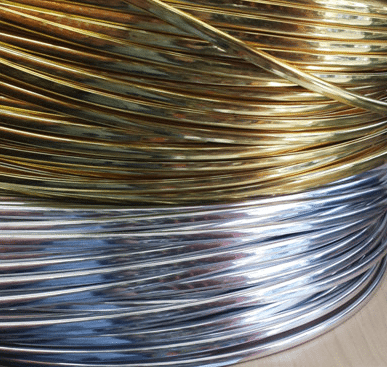
Electric conductivity is the movement of electrically charged particles. All metals conduct electricity to a certain extent, but certain metals are more highly conductive. The most highly conductive metals are silver, copper and gold.
Copper, for example, is highly conductive and commonly used in metal wiring. Brass, on the other hand, contains copper but other materials in its makeup reduce conductivity. Pure silver is the most conductive of all metals.
This list shows the conductive order of some commonly used metals and alloys, based on equal sizes.
The presence of valence electrons determines a metal’s conductivity. Valence electrons are “free electrons” that allow metals to conduct electric current. Free electrons move through metal like billiard balls, transferring energy as they knock into each other. Silver and copper are metals with single, free-moving valence electrons. The valance moves throughout the metal with little resistance, making these metals more conductive.
Semi-conductor metals have multiple valence electrons, which reduces the repelling reaction. Think of the 8 ball: when it hits one ball, it knocks it farther than if it gently bumps into multiple balls. Semi-conductors, however, can become more effective electrical conductors when heated or combined with other elements. The resistance of semiconductors depends on the presence of impurities in the metal. In addition to impurities, other factors that can affect how a metal conducts electricity include frequency, electromagnetic fields and temperature.
Silver has the highest conductivity of all metals, but it also has a hefty price tag and it can tarnish, rendering the surface less conductive. Gold is more corrosion-resistant.

Photo by Ra Dragon from Unsplash
Copper’s high conductivity and affordability make it a more appealing choice. Copper is also very fabricable, but many shops are not willing to give it a try.
Copper is something that can be regularly purchased in most supply chains. Copper materials will come in multiple shapes, sizes and thicknesses. For example, one can purchase flat sheet copper, usually in sheets that range in thickness from .0315″ to .0625″.
Another common way of expressing sheet thickness is to call out the weight of the copper per square foot. A couple of common sheet thickness choices are 16 OZ copper, which is .0216″ and 32 OZ copper which is .0432″.
Sheets can also be purchased much thicker, up to .120″ to .250″, but these sizes are often much harder to find.
Most copper sheets come in width and length sizes like 36.00″ x 96.00″ or 36.00″ x 120.00″.
In addition to sheets, another very popular, electrically-related type of copper material is bar stock. Random examples of bar stock, for reference, include sizes like 1/8″ x 2.00″ or 1/4″ x 4.00″ or 1.00″ x 2.00″, or 3.00″ x 3.00″. There are dozens of bar stock sizes. Engineers are good at determining sizes and needed conductivity to create fabrication specifications.
All Metals Fabrication has used heavy copper bars, 3/4″ x 8.00″, to create fabricated parts for electrical currents in large, steel anodizing tanks. We are not experts in electrical engineering, but we are experts in copper fabrication techniques.
Copper should always remain packaged and protected during the fabrication process. This can be accomplished by applying a PVC coating that can be peeled off after the fabrication process is completed.
The goal is to avoid abrasion and to keep the metal clean. Compared to steel, copper takes a much gentler approach to handling and fabricating, hence the reason that many fabrication job shops shy away from this type of work.
Copper is a much softer alloy than typical steel and it must be handled carefully. Again, the goal is to avoid deep scratches, dents, divots and dings—anything like that will make the materials less effective for its intended use.
Cutting, forming, rolling and joining (welding or soldering) are all common copper fabrication techniques.
People are usually aware that copper can be cut and formed, but many are unaware that copper can be welded, most commonly using GTAW or Gas Tungsten Arc Welding.
Copper is the go-to material for electrical conductivity, but other materials, listed above, are also available. All these materials, just like copper, are items that All Metals Fabrication can fabricate. Aluminum, zinc, brass, bronze and stainless steel are all materials that we manufacture on a daily basis.
All Metals Fabrication is an industry leader in fabricating materials that steel only job shops avoid.
Contact us at info@allmetalsfab.com to learn more.